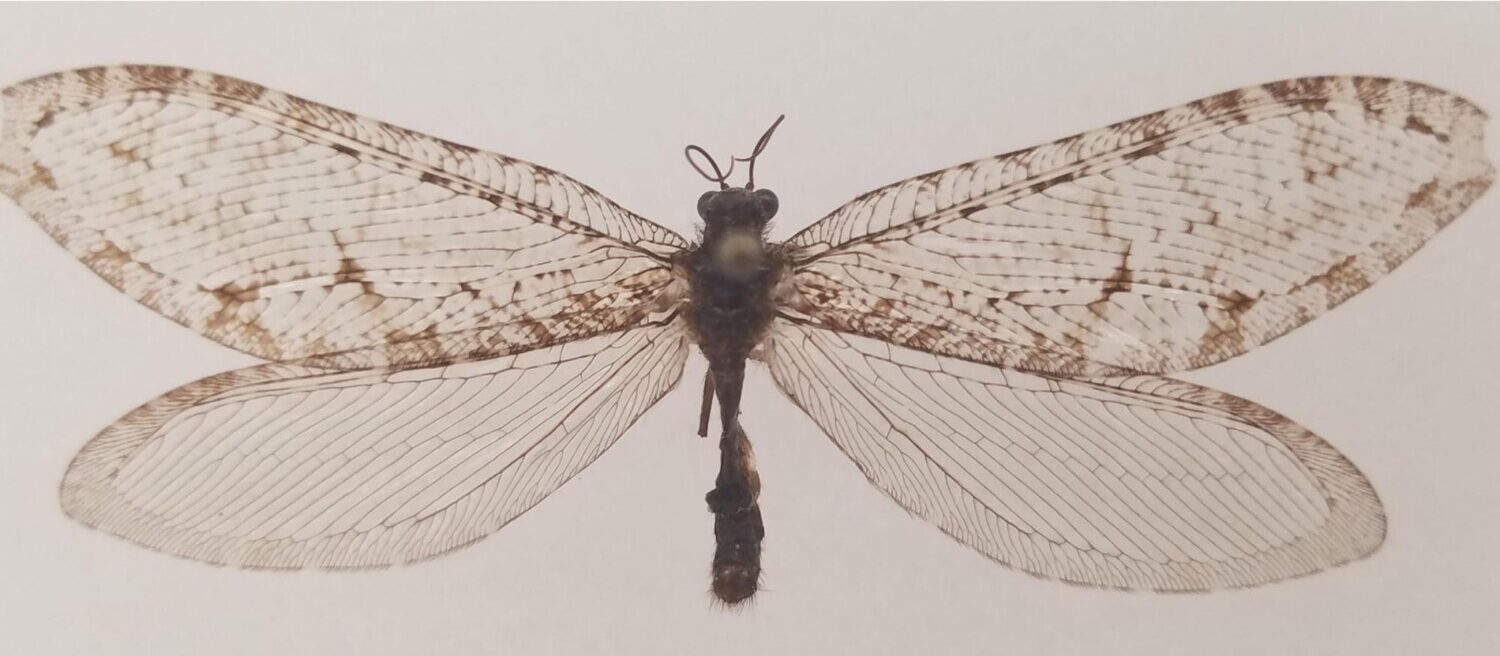Science
Rare insect found outside a Walmart dates back to the Jurassic

|
|
A quick trip to Walmart led to rare a discovery after a university scientist found a historic insect dating back to the Jurassic period.
Michael Skvarla, director of Penn State University’s Insect Identification Lab, found the large insect outside a Walmart in Fayetteville, Arkansas in 2012 when he was a doctoral student at the University of Arkansas.
“I remember it vividly because I was walking into Walmart to get milk, and I saw this huge insect on the side of the building,” he said in a press release from Penn State. “I thought it looked interesting, so I put it in my hand and did the rest of my shopping with it between my fingers. I got home, mounted it and promptly forgot about it for almost a decade.”
Skvarla initially misidentified the specimen but learned its true identity in 2020 while teaching an online course based on his personal insect collection. Skvarla used his own specimen samples to teach the class, which was held via Zoom due to the pandemic.
Though he originally thought it to be an antlion, Skvarla noticed that the insect’s characteristics didn’t quite match up during the course. Students then got to work comparing features and discovered that it is actually a giant lacewing dating back to the Jurassic period.
Penn State University
The finding has since been confirmed via DNA testing, and the insect is now in the collections of the Frost Entomological Museum at Penn State, where scientists and students will use it for further research.
Skvarla says the discovery likely reveals a larger story about biodiversity and a changing environment. He said the giant lacewing’s disappearance from North America largely remains a mystery; scientists hypothesize everything from the increase in artificial light to the introduction of non-native predators as potential causes.
After researchers analyzed collection records of giant lacewings and placed them onto a map to see their distribution, they realized that the Fayetteville specimen was the first spotted in eastern North America in more than 50 years.
How the insect ended up on the side of a well-lit Walmart is another mystery, but Skvarla says it suggests the bug was attracted to light and may have flown at least a few hundred meters from where it originated.
“It could have been 100 years since it was even in this area, and it’s been years since it’s been spotted anywhere near it,” he said in the release. “The next closest place that they’ve been found was 1,200 miles away, so very unlikely it would have traveled that far.”
Researchers suspect the insect represents a rare, surviving population of North American giant lacewings that have evaded detection and extinction for millions of years — a finding that highlights an everyday situation can lead to a historic discovery.


New dinosaur fossil has a lot in common with its bird relatives
The fossil was recently discovered in China.





Science
WATCH — This tiny fish is louder than an elephant – CBC.ca


These fish are also transparent
Danionella cerebrum may be small fry, but the noises they make are anything but.
Think louder than an elephant.
These tiny fish, which measure up to 12 millimetres long, were the subject of a study published in the journal Proceedings of the National Academy of Sciences on Feb. 24.
Researchers from the Charité Universitätsmedizin, a university hospital in Berlin, and the Senckenberg Society Natural History Collections in Dresden, both in Germany, collaborated on the study.
Their research uncovered the apparatus that allows male Danionella cerebrum fish to make loud, pulsing noises, and theorizes why this behaviour evolved in the first place.
Researchers recorded the fish in a tank. This video is slowed down 10 times to see how they moved. (Video credit: Verity Cook/Charité)
How did the study work?
The researchers put four Danionella cerebrum in a tank.They captured both audio and visual recordings, and performed scans, dissections and gene analyses.
Because these fish have transparent skin, cameras could see and record what happens inside their bodies to make such loud noises.


A study model shows how the Danionella cerebrum creates its sounds. A drumming muscle (green) contracts, pulling the rib (red), which fits into a groove in the cartilage (light blue) and builds tension. The tension is released and the cartilage snaps back into place, striking the swim bladder (purple). (Video credit: Verity Cook/Charité)
First, a special drumming muscle contracts.
It pulls on a rib that moves something called the drumming cartilage out of place — a bit like stretching a rubber band.
Then, suddenly, the drumming cartilage snaps back into position so fast it strikes the swim bladder (a special organ fish have to help them swim).
This impact produces the loud pulse we hear.
Click play on the video at the top of the page to hear the Danionella cerebrum for yourself!
Why so loud?
The noises made by male Danionella cerebrum can be as loud as 147 decibels at a distance of one body length away.
That’s about as loud as a jet engine would sound taking off 100 metres away from you.
The researchers believe these pulses are a way for the fish to communicate.
Danionella cerebrum’s native habitat are shallow, murky waters in Myanmar.
The scientists say this lack of visibility could mean sound communication evolved to help the fish locate mates.


The Danionella cerebrum is about as long as the diameter of a typical AA battery. (Image credit: Senckenberg, with graphic design by Philip Street/CBC)
A unique opportunity
The study broadens our understanding of how animals make noise and why these behaviours might have evolved.
Now, the scientists hope to study the four other species in the Danionella family, to compare how they produce sounds.
Click play to hear the itsy-bitsy fish for yourself!
Check out these other animal news videos:
Have more questions? Want to tell us how we’re doing? Use the “send us feedback” link below. ⬇️⬇️⬇️
TOP IMAGE CREDIT: Senckenberg, with graphic design by Philip Street/CBC
Science
Local astronomer urges the public to look up – Windsor News Today – windsornewstoday.ca


If last week’s solar eclipse piqued your interest in astronomy, the Royal Astronomical Society of Canada’s Windsor Chapter plans to show off some of the more dramatic photos and videos members took of the event.
They were stationed along the path of totality along the northern shore of Lake Erie and in the U.S.
“People did take some nice photos with their cellphones, but we have members who took photos and videos with their telescopes,” said member Tom Sobocan. “You’ll see some pretty impressive shots.”
About 100 members are in the local chapter, which meets every third Tuesday of every month.
Thursday’s meeting is at the Ojibway Nature Centre on Matchette Road. It starts at 7:30, and it’s open to the public. Seating is limited, so Sobocan recommends arriving early.
Astronomers are looking ahead to new wonders in the heavens. Right now, the Pons-Brooks Comet, another once-in-a-lifetime opportunity, is approaching Jupiter in the constellation of Aries.
“If you’re in a dark-sky location, you can see it with the naked eye, and from inside the city, you can see it with binoculars,” said Sobocan. “It may get a little bit brighter going towards the fall, but our members have already photographed it with their telescopes.”
It’s a periodic comet which appears in the night sky once every 71 years.
Sobocan said once-in-a-lifetime events, like last week’s eclipse, inspired many of its existing members, but he hopes some new ones will join the group.
“I hope it inspires them to look up at the sky a little bit more often and realize that everything’s in motion in the sky,” he said. “It’s not stationary.”
Science
Giant, 82-foot lizard fish discovered on UK beach could be largest marine reptile ever found – Livescience.com


Scientists have unearthed the remains of a gigantic, 200 million-year-old sea monster that may be the largest marine reptile ever discovered.
The newfound creature is a member of a group called ichthyosaurs, which were among the dominant sea predators during the Mesozoic era (251.9 million to 66 million years ago). The newly described species lived during the end of the Triassic period (251.9 million to 201.4 million years ago).
Ichthyosaurs had already attained massive sizes by the early portion of the Mesozoic, but it was not until the late Triassic that the largest species emerged.
While the Mesozoic is known as the age of the dinosaurs, ichthyosaurs were not themselves dinosaurs. Instead, they evolved from another group of reptiles. Their evolutionary path closely mirrors that of whales, which evolved from terrestrial mammals that later returned to the sea. And like whales, they breathed air and gave birth to live young.
The newly discovered ichthyosaur species was unearthed in pieces between 2020 and 2022 at Blue Anchor, Somerset in the United Kingdom. The first chunk of the fossil was noticed atop a rock on the beach, indicating that a passerby had found it and set it there for others to examine, the researchers explained in the paper. The researchers published their findings April 17 in the journal PLOS One.
The reptile’s remains are made up of a series of 12 fragments from a surangular bone, which is found in the upper portion of the lower jaw. The researchers estimate the bone was 6.5 feet (2 meters) long and that the living animal was about 82 feet (25 m) long.
The researchers named the sea monster Ichthyotitan severnensis, meaning giant lizard fish of the Severn, after the Severn Estuary where it was found. The team believes it is not only a new species but an entirely new genus of ichthyosaur. More than 100 species are already known.
window.sliceComponents = window.sliceComponents || ;
externalsScriptLoaded.then(() => {
window.reliablePageLoad.then(() => {
var componentContainer = document.querySelector(“#slice-container-newsletterForm-articleInbodyContent-5Tm52KifRnJsTxFt8noX8R”);
if (componentContainer)
var data = “layout”:”inbodyContent”,”header”:”Sign up for the Live Science daily newsletter now”,”tagline”:”Get the worldu2019s most fascinating discoveries delivered straight to your inbox.”,”formFooterText”:”By submitting your information you agree to the Terms & Conditions and Privacy Policy and are aged 16 or over.”,”successMessage”:”body”:”Thank you for signing up. You will receive a confirmation email shortly.”,”failureMessage”:”There was a problem. Please refresh the page and try again.”,”method”:”POST”,”inputs”:[“type”:”hidden”,”name”:”NAME”,”type”:”email”,”name”:”MAIL”,”placeholder”:”Your Email Address”,”required”:true,”type”:”hidden”,”name”:”NEWSLETTER_CODE”,”value”:”XLS-D”,”type”:”hidden”,”name”:”LANG”,”value”:”EN”,”type”:”hidden”,”name”:”SOURCE”,”value”:”60″,”type”:”hidden”,”name”:”COUNTRY”,”type”:”checkbox”,”name”:”CONTACT_OTHER_BRANDS”,”label”:”text”:”Contact me with news and offers from other Future brands”,”type”:”checkbox”,”name”:”CONTACT_PARTNERS”,”label”:”text”:”Receive email from us on behalf of our trusted partners or sponsors”,”type”:”submit”,”value”:”Sign me up”,”required”:true],”endpoint”:”https://newsletter-subscribe.futureplc.com/v2/submission/submit”,”analytics”:[“analyticsType”:”widgetViewed”],”ariaLabels”:;
var triggerHydrate = function()
window.sliceComponents.newsletterForm.hydrate(data, componentContainer);
if (window.lazyObserveElement)
window.lazyObserveElement(componentContainer, triggerHydrate);
else
triggerHydrate();
}).catch(err => console.log(‘Hydration Script has failed for newsletterForm-articleInbodyContent-5Tm52KifRnJsTxFt8noX8R Slice’, err));
}).catch(err => console.log(‘Externals script failed to load’, err));
A number of rib fragments and a coprolite, or fossilized feces, were found in the area as well, but they were not definitively attributed to the same animal.
The sediments in which these specimens were found contained rocks that indicated earthquakes and tsunamis occurred during that time, which suggests that this species lived during a time of intense volcanic activity that may have led to a massive extinction event at the end of the Triassic according to the researchers.
A similar specimen was discovered in Lilstock, Somerset in 2016 and described in 2018. Both were found in what is known at the Westbury Mudstone Formation, within 6 miles (10 kilometers) of each other. This ichthyosaur was estimated to have been as much as 85 feet (26 m) long, although the authors of the latest study believe it was slightly smaller.
The previous contender for the largest marine reptile was another ichthyosaur, Shonisaurus sikanniensis, which was up to 69 feet (21 m) long. S. sikanniensis appeared 13 million years earlier than I. severnensis and was found in British Columbia, making it unlikely that the new discovery represents another specimen of the previously known species.
A similarly massive ichthyosaur called Himalayasaurus tibetensis, which may have reached lengths of 49 feet (15 m), was discovered in Tibet and described in 1972. It dates to the same period, meaning that it probably is not the same species as the new discovery either.
I. severnensis was likely among the last of the giant ichthyosaurs, the researchers claim. Ichthyosaurs persisted into the Cenomanian Age (100.5 million to 93.9 million years ago) of the late Cretaceous period (100.5 million to 66 million years ago). They were eventually supplanted by plesiosaurs — long-necked marine reptiles that went extinct at the end of the Cretaceous, alongside all non-avian dinosaurs.
-
Business23 hours ago
Rupture on TC Energy's NGTL gas pipeline sparks wildfire in Alberta – The Globe and Mail
-
Investment23 hours ago
Saudi Arabia Highlights Investment Initiatives in Tourism at International Hospitality Investment Forum
-



 Tech16 hours ago
Tech16 hours agoCytiva Showcases Single-Use Mixing System at INTERPHEX 2024 – BioPharm International
-
Art23 hours ago
Squatters at Gordon Ramsay's Pub Have 'Left the Building' After Turning It Into an Art Café – PEOPLE
-



 Science22 hours ago
Science22 hours agoNasa confirms metal chunk that crashed into Florida home was space junk
-



 Politics23 hours ago
Politics23 hours agoThe Earthquake Shaking BC Politics
-
News18 hours ago
Tim Hortons says 'technical errors' falsely told people they won $55K boat in Roll Up To Win promo – CBC.ca
-



 Investment22 hours ago
Investment22 hours agoBill Morneau slams Freeland’s budget as a threat to investment, economic growth





